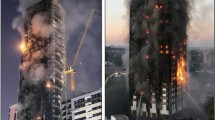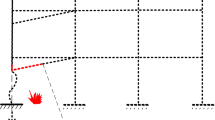Abstract
The fire resistance of concentrically loaded reinforced concreted bearing walls with all-sided fire exposure was theoretically and experimentally investigated. The proposed model for predicting the axial behavior of bearing walls considers complex features of the wall in a fire, such as thermal expansion, change of material properties with temperature and spalling of concrete. Comparison with the experimental observations made for a total of eight reinforced concrete walls showed that the model could reasonably simulate the axial behavior of these walls. Using the model, wall thickness and the level of axial load were identified as major parameters influencing the fire resistance. The accuracy of fire resistance provided in different codes was also reviewed. Based on the model predictions, a practical formula for the fire resistance has been derived in terms of wall thickness and the ratio of axial load to the nominal strength of the wall. A close agreement in fire resistance was observed between the predictions made by the model modified with a reduction factor and those from Eurocode 2.













Similar content being viewed by others
References
ACI Committee 318 (2011) Building code requirements for structural concrete and commentary. American Concrete Institute, Farmington Hills
ACI/TMS Committee 216 (1989) Guide for determining the fire endurance of concrete elements (ACI 216R-89), Reapproved 2001. American Concrete Institute, Farmington Hills
Anderberg Y, Thelandersson S (1976) Stress and deformation characteristics of concrete at high temperatures, 2. Experimental investigation and material behavior model. Bulletin 54, Lund Institute of Technology, Lund
Anderberg Y, Therlanderson S (1978) A constitutive law for concrete at transient high temperature conditions. American Concrete Institute SP-55, pp 187–205
AS 3600 (2001) Concrete structures. Standards Association of Australia, Sydney
ASCE/SFPE (2007) Standard calculation methods for structural fire protection (29-05). American Society of Civil Engineers
Chan SYN, Peng GF, Anson M (1999) Fire behavior of high-performance concrete made with silica fume at various moisture contents. ACI Mater J 92(3):405–409
Cozier DA, Sanjayan JD (2000) Tests of load-bearing slender reinforced concrete walls in fire. ACI Struct J 97(2):243–251
Dorn JE (1954) Some fundamental experiments on high temperature creep. J Mech Phys Solids 3(2):86–116
Draft International Standard (1999) ISO/FDIS 834-1: 1 1999(E):12–26
Dwaikat MB, Kodur VKR (2008) Hydrothermal model for predicting fire-induced spalling in concrete structural systems. Fire Saf J 44(3):425–434
Eurocode 2 (2004) Design of concrete structures. Part 1–2: General rules-structural fire design prEN1992-1-2. European Standard
Gawin D, Pesavento F, Schrefler BA (2006) Towards prediction of the thermal spalling risk through a multi-phase porous media model of concrete. Comput Methods Appl Mech Eng 195:5702–5729
Hsu J-H, Lin C-S, Huang C-B (2006) Modeling the effective elastic modulus of RC beams exposed to fire. J Mar Sci Technol 14(2):102–108
ISO (1975) Fire resistance tests-elements of building construction, ISO 834-1975. International Organization of Standardization, Geneva
Kodur VKR, Phan L (2007) Critical factors governing the fire performance of high strength concrete systems. Fire Saf J 42:482–488
Kodur VKR, Wang TC, Cheng FP (2004) Predicting the fire resistance behavior of high strength concrete columns. Cem Concr Compos 26(2):141–153
Li L, Purkiss J (2005) Stress–strain constitutive equation of concrete material at elevated temperature. Fire Saf J 40:669–686
Lie TT (1992) Structural fire protection. American Society of Civil Engineers, New York
Lie TT, Irwin RJ (1993) Method to calculate the fire resistance of reinforced concrete columns with rectangular cross section. ACI Struct J 90(1):52–60
Malhotra HL (1982) Design of fire-resisting structures. Surrey University, London
Malhotra HL (1984) Spalling of concrete in fires. CIRIA Technical Note No. 118. Construction Industry Research and Information Association, London
NZS 3101 (1995) Concrete structures standard. Part 1—The design of concrete structures. New Zealand Standards
O’Meagher AJ, Bennetts ID (1991) Modeling of concrete walls in fire. Fire Saf J 17:315–335
Ongah R, Mendis PA (2002) Fire performance of high strength reinforced concrete walls. In: Mechanics of structures and materials, pp 199–204
Phan LT (1996) Fire performance of high-strength concrete: a report of the state-of-the-art, National Institute of Standards and Technology, Gaithersburg
Plem E (1975) Theoretical and experimental investigations of point set structures. Document D9. Swedish Council for Building Research, Copenhagen
Purkiss JA (1996) Fire safety engineering design of structures. Butterworth Heinemann, Oxford
Scott BD, Park R, Priestley MJN (1982) Stress–strain behavior of concrete confined by overlapping hoops at low and high strain rate. ACI J 79(1):13–27
Terro M (1998) Numerical modeling of the behavior of concrete structures in fire. ACI Struct J 95(2):183–190
Xiao J, Konig G (2004) Study on concrete at high temperature in China—an overview. Fire Saf J 39:89–103
Acknowledgments
This research was supported by the Chung-Ang University Research Scholarship Grants in 2007.
Author information
Authors and Affiliations
Corresponding author
Rights and permissions
About this article
Cite this article
Lee, S., Lee, C. Fire resistance of reinforced concrete bearing walls subjected to all-sided fire exposure. Mater Struct 46, 943–957 (2013). https://doi.org/10.1617/s11527-012-9945-8
Received:
Accepted:
Published:
Issue Date:
DOI: https://doi.org/10.1617/s11527-012-9945-8




